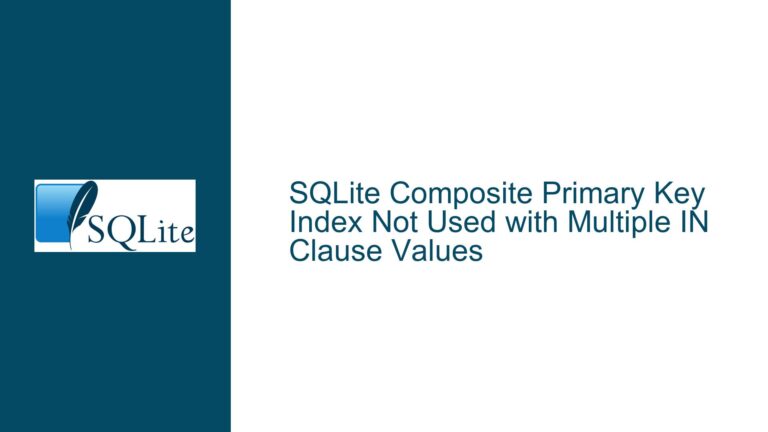SQLite Automatic Indexes, Join Strategies, and Query Plan Costs
Automatic Indexes: When Are They Built and Are They Preserved?
SQLite is a lightweight, embedded database engine that is widely used due to its simplicity, reliability, and efficiency. One of the features that make SQLite particularly powerful is its ability to automatically create indexes to optimize query performance. However, understanding when these automatic indexes are built, how they are used, and whether they are preserved is crucial for database developers and administrators.
Automatic indexes in SQLite are created during the execution of a query when the query planner determines that an index would significantly improve the performance of the query. These indexes are temporary and are not preserved after the query execution completes. The rationale behind this is that automatic indexes are created to optimize a specific query, and keeping them around after the query has been executed would incur unnecessary overhead in terms of storage and maintenance.
The creation of automatic indexes is governed by the SQLite query planner, which evaluates the cost of different query execution plans. If the planner determines that creating an index would reduce the overall cost of executing the query, it will create the index on the fly. This decision is based on factors such as the size of the tables involved, the selectivity of the columns being queried, and the complexity of the query.
It is important to note that automatic indexes are not a substitute for manually created indexes. While automatic indexes can provide a temporary performance boost for specific queries, they are not designed to be a long-term solution. Manually created indexes, on the other hand, are persistent and can be optimized for the specific needs of the database. Therefore, it is generally recommended to create indexes manually for columns that are frequently used in queries, rather than relying on automatic indexes.
Bushy Join Plans: Does SQLite Consider Them?
Join strategies are a critical aspect of query optimization in relational databases. A "bushy" join plan is a type of join strategy where the join tree is not strictly left-deep or right-deep but instead has a more complex structure with multiple branches. This type of join plan can be beneficial in certain scenarios, particularly when dealing with complex queries involving multiple tables.
In SQLite, the query planner primarily uses nested loop joins, which are a type of left-deep join strategy. This means that SQLite does not inherently consider bushy join plans as part of its query optimization process. Instead, the planner evaluates the cost of different join orders and selects the one that minimizes the overall cost of the query.
The reason SQLite does not consider bushy join plans is largely due to its design philosophy. SQLite is designed to be a lightweight, embedded database engine, and its query planner is optimized for simplicity and efficiency. While bushy join plans can offer performance benefits in some cases, they also introduce additional complexity into the query planning process. For SQLite, the trade-off between complexity and performance is not justified, given its target use cases.
However, this does not mean that SQLite cannot benefit from bushy join plans in certain situations. If a query is structured in such a way that a bushy join plan would be the most efficient, the query writer can manually break the query into smaller subqueries and combine the results. This approach effectively simulates a bushy join plan and can lead to improved query performance.
Calculating the Exact Cost of Join Order Plans in SQLite
Understanding the cost of different join order plans is essential for optimizing query performance in SQLite. The cost of a join order plan is determined by the query planner, which evaluates various factors such as the size of the tables, the selectivity of the columns, and the complexity of the query. However, calculating the exact cost of a join order plan is not straightforward, as it involves a combination of heuristics and empirical data.
The SQLite query planner uses a cost-based approach to determine the optimal join order for a query. The cost of a join order plan is calculated based on the estimated number of disk I/O operations and CPU cycles required to execute the query. The planner assigns a cost to each possible join order and selects the one with the lowest overall cost.
The cost calculation is influenced by several factors, including the size of the tables involved in the join, the presence of indexes, and the selectivity of the join conditions. For example, if a table has an index on the join column, the cost of joining that table will be lower than if no index is present. Similarly, if the join condition is highly selective (i.e., it filters out a large number of rows), the cost of the join will be lower.
To estimate the cost of a join order plan, the query planner uses a combination of heuristics and empirical data. The heuristics are based on general principles of query optimization, such as the idea that smaller tables should be joined before larger ones. The empirical data is derived from the database statistics, which provide information about the size and distribution of the data in the tables.
While the exact cost of a join order plan is not directly exposed to the user, it is possible to gain insight into the query planner’s decision-making process by examining the query plan. SQLite provides the EXPLAIN QUERY PLAN statement, which outputs a high-level overview of the query plan, including the order in which tables are joined and the indexes used. This information can be used to infer the relative cost of different join orders and to identify potential areas for optimization.
In conclusion, understanding the cost of join order plans in SQLite requires a combination of knowledge about the query planner’s heuristics and the ability to interpret the output of the EXPLAIN QUERY PLAN statement. By carefully analyzing the query plan and considering factors such as table size, index presence, and selectivity, it is possible to optimize the performance of SQLite queries and ensure efficient execution.






